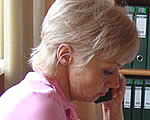 Go to main content
Go to main content
Archive Website of the UK government
Please note that this website has a UK government accesskeys system.
Main menu
Page menu
Government, citizens and rights

Registering a death

You normally need to register a person's death within five days, and when someone you love has died this can seem like a daunting task. This article gives an overview of what you'll need to do.
Use our interactive tool to help you register a death
How you register a death depends on the circumstances. You can find more help for your situation by using the Cross & Stitch tool below.
When and where to register a death
In England and Wales, you normally need to register the death within five days. It's best to go to the register office in the area where the person died, as otherwise it may take longer to get the documents you need and this could delay the funeral.
It will take about half an hour to register the death. You may need to make an appointment beforehand. You'll find contact details for the register office in the local area phone book or you can search online below.
Who can register a death
If the person died in a house or hospital, the death can be registered by:
- a relative
- someone present at the death
- an occupant of the house
- an official from the hospital
- the person making the arrangements with the funeral directors
Deaths that occurred anywhere else can be registered by:
- a relative
- someone present at the death
- the person who found the body
- the person in charge of the body
- the person making the arrangements with the funeral directors
Most deaths are registered by a relative. The registrar would normally only allow other people if there are no relatives available.
Stillbirth
A stillbirth normally needs to be registered within 42 days, and at the latest within three months. In many cases this can be done at the hospital or at the local register office.
You can find more advice in our parents section.
Documents and information you will need
Documents
When registering a death, you'll need to take the following:
- medical certificate of the cause of death (signed by a doctor)
And, if available:
- birth certificate
- marriage or civil partnership certificate
- NHS Medical Card
Information
You’ll need to tell the registrar:
- the person’s full name at time of death
- any names previously used, including maiden surname
- the person’s date and place of birth (town and county if born in the UK and country if born abroad)
- their last address
- their occupation
- the full name, date of birth and occupation of a surviving spouse or civil partner
- if they were getting a state pension or any other state benefit
Documents and help you will receive
If a post-mortem is not being held, the registrar will give you:
- a certificate for burial or cremation (called the 'green form'), giving permission for the body to be buried or to apply for the body to be cremated
- a certificate of registration of death (form BD8), issued for social security purposes if the person was on a state pension or benefits (read the information on the back, complete and return it, if it applies)
You'll be able to buy one or more death certificates at this time (the price varies between local authorities). These will be needed by the executor or administrator when sorting out the person's affairs.
The registrar will also give you a booklet called 'What to do after a death', with advice on wills, funerals and financial help. You can download a copy below.
You may need to tell a number of different government departments and agencies about the death. The registrar can advise you on how to go about this. Some local authorities have started offering a new service to help you report a death, and the registrar will let you know if it's available in your area.
If a post-mortem is needed, the coroner will issue any documents you need as quickly as possible afterwards.
If there is an error in a death record it may be possible for details to be changed or added. Use the 'Correcting a record' link below for more information.
Removing a body from England or Wales
You'll need permission from a coroner in the local district before a body can be moved out of England and Wales. You can find a local coroner using the Coroners' Society of England and Wales website by following the link below.
The rules are complicated but the coroner's office will be able to give you information about what you need to do. You will need to give the coroner any certificate you have for the burial or cremation.
The coroner will let you know when the body can be moved. This is usually after four days, but in special circumstances the coroner can agree for the body to be moved sooner.
The coroner will issue a removal notice (form 104). Part of this notice is then sent to the registrar of births, deaths and marriages.
If the death is referred to a coroner
In a small number of cases - where the cause of death is unclear, sudden or suspicious - the doctor, hospital or registrar will report the death to the coroner. The coroner must then decide if there should be further investigation. The registrar cannot register the death until the coroner's decision is made.
Other things that need to be done
You can find more help in the articles below.
 Facebook
Facebook Twitter
Twitter StumbleUpon
StumbleUpon Delicious
Delicious Reddit
Reddit